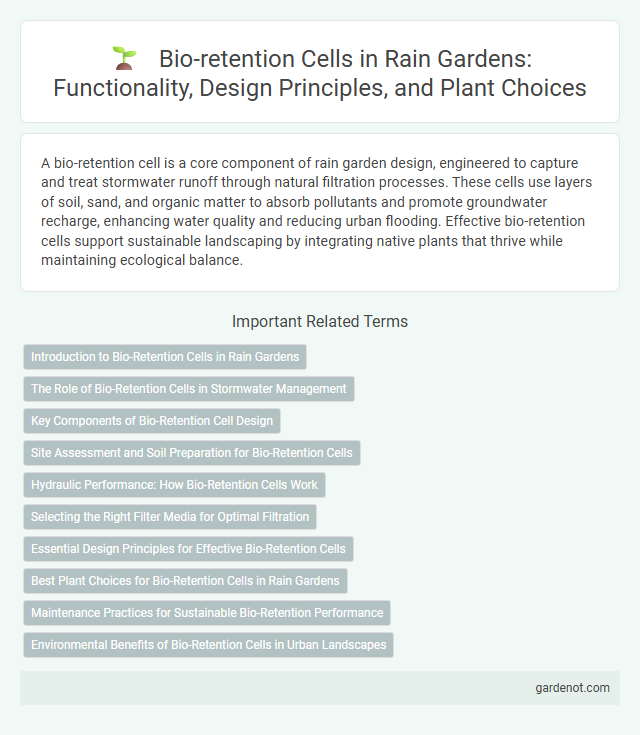A bio-retention cell is a core component of rain garden design, engineered to capture and treat stormwater runoff through natural filtration processes. These cells use layers of soil, sand, and organic matter to absorb pollutants and promote groundwater recharge, enhancing water quality and reducing urban flooding. Effective bio-retention cells support sustainable landscaping by integrating native plants that thrive while maintaining ecological balance.
Introduction to Bio-Retention Cells in Rain Gardens
Bio-retention cells in rain gardens are engineered depressions designed to capture and treat stormwater runoff through filtration and infiltration. These systems use layers of soil, sand, and organic mulch to remove pollutants, reduce runoff volume, and promote groundwater recharge. Effective bio-retention cells support urban sustainability by improving water quality and mitigating flood risks.
The Role of Bio-Retention Cells in Stormwater Management
Bio-retention cells serve a crucial function in stormwater management by capturing and filtering runoff through engineered soil layers and vegetation, effectively reducing pollutants and sediment before water infiltrates into groundwater or is released to waterways. These systems mitigate urban flooding by slowing runoff flow rates and increasing water infiltration, which helps replenish local aquifers. Their design integrates native plants that enhance pollutant uptake and provide habitat value, contributing to improved water quality and ecosystem health.
Key Components of Bio-Retention Cell Design
Key components of bio-retention cell design include an engineered soil media composed of sand, compost, and soil to facilitate infiltration and pollutant removal. A gravel underdrain system supports drainage while preventing waterlogging, and a vegetative layer with native plants stabilizes soil and enhances nutrient uptake. Additionally, an overflow bypass structure manages excess stormwater, ensuring system durability during heavy rainfall events.
Site Assessment and Soil Preparation for Bio-Retention Cells
Effective site assessment for bio-retention cells involves analyzing soil permeability, slope, and existing vegetation to ensure optimal water infiltration and retention. Soil preparation requires amending native soils with organic matter and sand to enhance drainage while maintaining nutrient retention, critical for healthy plant growth. Proper grading and removal of compacted layers create a suitable environment for bio-retention systems to filter pollutants and manage stormwater effectively.
Hydraulic Performance: How Bio-Retention Cells Work
Bio-retention cells function by capturing and temporarily storing stormwater runoff, allowing it to infiltrate the soil and reducing surface water flow. These cells use specialized vegetation and engineered soil media to enhance pollutant removal and improve water quality while supporting groundwater recharge. The hydraulic performance depends on factors such as soil permeability, cell size, and vegetation type, which together optimize flow rates and minimize flooding risks.
Selecting the Right Filter Media for Optimal Filtration
Choosing the right filter media in a bio-retention cell is essential for maximizing stormwater filtration and nutrient removal. A mix of sand, compost, and topsoil tailored to achieve high infiltration rates while retaining contaminants ensures efficient pollutant capture and supports healthy plant growth. Optimized filter media enhances water quality by effectively reducing sediment, heavy metals, and nitrogen, contributing to sustainable rain garden performance.
Essential Design Principles for Effective Bio-Retention Cells
Effective bio-retention cells incorporate key design principles including proper soil media composition with high infiltration rates, graded to facilitate optimal stormwater capture and pollutant removal. Incorporating native vegetation with deep root systems enhances water filtration and supports micro-ecosystem biodiversity. Adequate overflow structures prevent flooding, ensuring the bio-retention cell functions efficiently during heavy rainfall events.
Best Plant Choices for Bio-Retention Cells in Rain Gardens
Native grasses such as Switchgrass (Panicum virgatum) and Little Bluestem (Schizachyrium scoparium) are top plant choices for bio-retention cells due to their deep root systems that enhance soil infiltration. Perennials like Blue Flag Iris (Iris versicolor) and Joe-Pye Weed (Eutrochium purpureum) thrive in moist conditions, supporting pollutant removal and providing habitat diversity. Incorporating shrubs like Red Twig Dogwood (Cornus sericea) improves structural stability and maximizes stormwater filtration in rain garden bio-retention cells.
Maintenance Practices for Sustainable Bio-Retention Performance
Regular inspection and removal of sediment and debris in bio-retention cells are essential for maintaining optimal infiltration rates and preventing clogging. Periodic mulching replenishes organic matter, supports microbial activity, and enhances pollutant breakdown within the rain garden. Vegetation management, including pruning and replanting native species, ensures healthy plant growth and maximizes pollutant uptake for sustainable stormwater treatment.
Environmental Benefits of Bio-Retention Cells in Urban Landscapes
Bio-retention cells in urban landscapes significantly reduce stormwater runoff by capturing and filtering pollutants such as heavy metals, nutrients, and sediments, thereby improving water quality. They enhance groundwater recharge through natural infiltration processes, supporting local aquifers and mitigating urban flooding risks. Furthermore, bio-retention cells contribute to urban biodiversity by providing habitat for native plants and beneficial microorganisms, promoting ecological resilience in densely built environments.
Bio-retention cell Infographic

 gardenot.com
gardenot.com